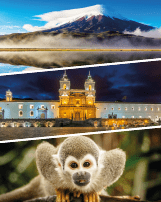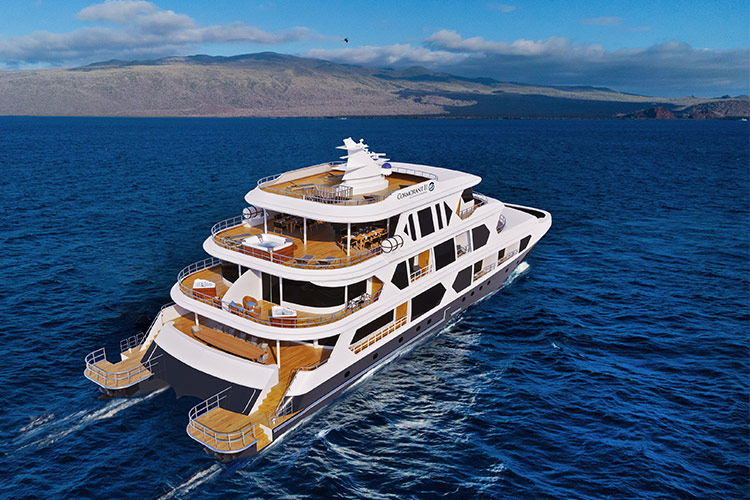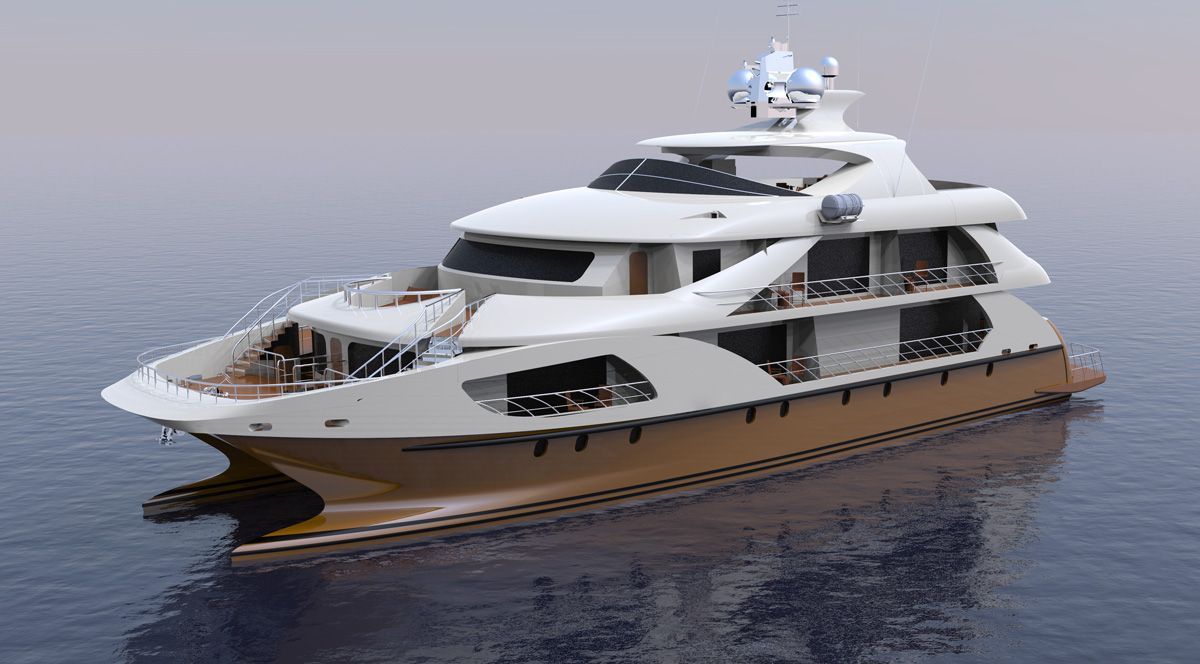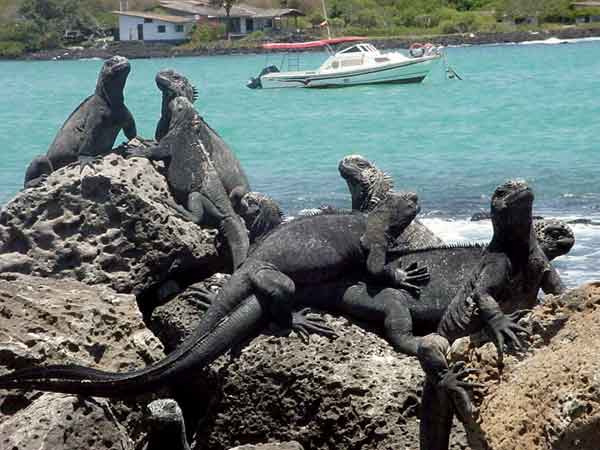Cruises
Experience the “Enchanted Islands” on board the M/C Alya Luxury Cruise, also known as “The Jewel of Galapagos” due to its design representing the perfection, the beauty and uniqueness of this exotic paradise.
Enjoy the majesty of a golden experience, delightful cuisine and personalized service in a comfortable and exclusive environment.
.
OUR CABINS
This comfortable Luxury Class Cruise offers 8 comfortable cabins with a unique and exclusive design, all them with private balcony, 4 cabins on the upper deck and 4 on the main deck.
MAIN DECK
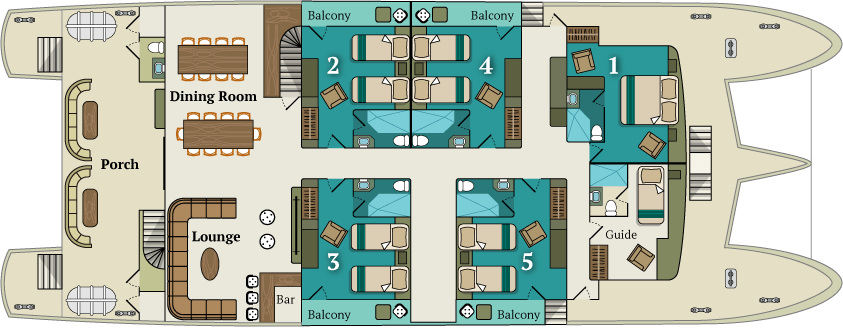
UPPER DECK
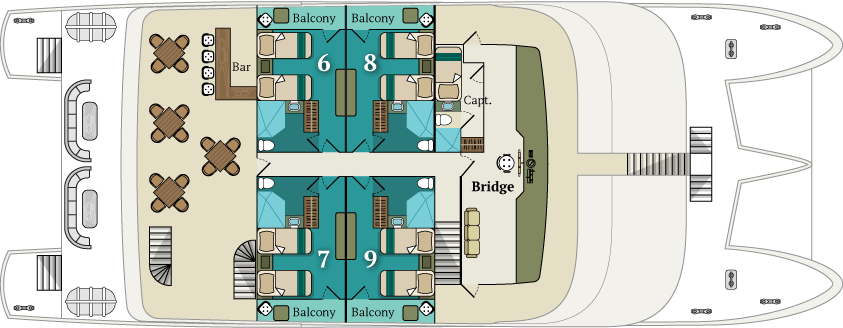
SUN DECK
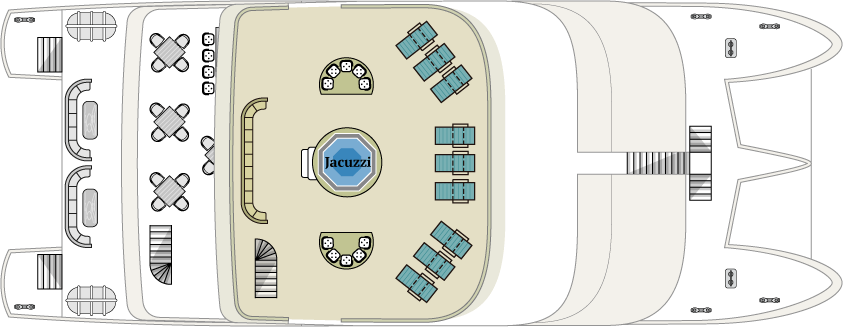
SPECIFICATIONS
| Year of construction: | 2017 |
| Type | Luxury Motor Catamaran |
| Length: | 105 ft (32 m) |
| Beam: | 43 ft (13 m) |
| Draft: | 5,6 ft (1.70 m) |
| Water capacity: | 2.500 gallons |
| Capacity: | 16 passengers |
| Accommodation: | Main Deck: One 205ft² / 19m² double cabin. Four 215ft² / 20m² double cabins with private balcony. Dining room and Lounge
Upper Deck: Four 172ft² / 16m² double cabins (all with private balcony). |
| Main engines: | 2 Cumming Motors 350 HP |
| Max speed: | 12 knots |
| Crew: | 9 Crew members + 1 Cruise Director + 1 Bilingual Guide |
| Electric Power: | 110V and 220V |
| Safety & Navigation: | All equipment meets / exceeds the international safety standards:
|
ITINERARIES
Day 1: Tuesday
– AM – Santa Cruz Island
Morning flight from Quito or Guayaquil to Baltra, Galapagos Islands.
You will arrive at Baltra Island in the morning. After passing through immigration and baggage claim, you will be met by a Alya staff member and transferred to the yacht. You will be shown to your cabin where you will have some time to settle in before lunch and a welcome briefing.
In North Seymour you will be able to see Galapagos sea lions, blue-footed boobies, and magnificent
frigatebirds which are abundant on this island. North Seymour was formed by a series of submarine lava flows containing layers of sediment that were uplifted by tectonic activity. The island is characterized by its arid vegetation zone.
Possible Activities: Dinghy ride & hiking (1.5 miles / 2.41 km)
Difficulty: Moderate / Difficult
Type of Landing: Dry landing
Highlights: Land & marine iguanas, frigatebirds, blue-footed boobies, sea lions; snorkeling: rays, reef sharks, fish, garden eels.
Day 2: Friday
– AM – Genovesa Island – Darwin Bay
In the morning, you will visit the white-sand coral beach of Darwin Bay which heads a half mile trail
(0,75km) that winds through mangroves filled with land birds. Nazca boobies, red-footed boobies, and swallow-tailed gulls can be spotted here. Further down the path we’ll find tidal pools where sea lions swim playfully. At the end is a spectacular view of a cliff.
Possible Activities: Hiking (0,9 miles / 1,5 Km), snorkeling, kayaking, and dinghy ride
Difficulty: Easy
Type of Landing: Wet landing
Highlights: Nazca boobies, red-footed boobies, swallow-tail gulls, mangroves, coral pebble beach, snorkeling: rays, colourful reef fish, and hammerhead sharks occasionaly
– PM – El Barranco
In the afternoon, you will visit El Barranco which is also known as Prince Phillip’s Steps. It is a steep, rocky path that leads up to a high cliff-face. A marvelous view can be appreciated from here. This site is also home to palo santo vegetation as well as red-footed boobies, short-eared lava owls, Galapagos swallows, and Galapagos doves.
Possible Activities: Hiking (0,9 miles / 2 Km)
Difficulty: Moderate
Type of Landing: Dry landing
Highlights: Red-footed boobies, short-eared lava owls, storm-petrels, Galapagos doves
Day 3: Saturday
– AM – Santiago Island – Sullivan Bay
In the morning, you will visit Sullivan Bay located on the southeast part of Santiago. This place is
interesting for its geology because the area is covered by lava flows. This place has elevations in the
form of small volcanoes formed by the lava flows.
Possible Activities: Hiking
Difficulty: Easy/Moderate
Type of Landing: Dry Landing
Highlights: Lava flows, small volcanoes
– PM – Bartholomew Island
In the afternoon, you will head to Bartholomew Island, home of the famous Pinnacle Rock. Bartholomew consists of an extinct volcano with a variety of red, orange, black and even green volcanic formations. We will take a trail of stairs to the summit of the volcano (about 30 or 40 minutes) where you will enjoy one of the best views of the islands! You will also visit a small, beautiful beach surrounded by the only vegetation found on this barren island. The beach is perfect for snorkeling where you may even see Galapagos penguins.
Possible Activities: Dinghy ride, snorkeling & hiking (1.2 miles/ 2 km)
Difficulty: Moderate/difficult. Walk up to the top of volcano 374 feet (114 meters), 375 wooden steps
Type of Landing: Dry and wet landings
Highlights & Animals: Pinnacle Rock, panoramic view, moonlike landscape, penguins, pioneer plants, lava cactus; snorkeling: penguins, reef sharks, rays, and great colorful fish.
Day 4: Sunday
– AM – Santa Cruz – Dragon Hill
In the morning, you will visit Dragon Hill on Santa Cruz. The visitors’ site at Dragon Hill is located on the northwestern part of Santa Cruz Island and consists of a trail that runs through three different environments although it is only slightly less than a mile long (1,600 meters). The beach is very rocky. At high tide it’s a nice place for snorkeling. At this visiting site you can find vegetation typical of the intertidal and dry zones.
Possible Activities: Dinghy ride and short hike
Difficulty: Easy
Type of Landing: Dry landing
Highlights: Fragatebirds, herons, blue-footed boobies, rays, reef sharks
– PM – Black Turtle Cove
In the afternoon you will visit Black Turtle Cove on the northern part of Santa Cruz Island. This islet is surrounded by mangroves and is only accessible by dinghy. The shallow cove is a haven for young marine life. Black-tip and white-tip reef sharks, sea turtles, and a variety of rays are often spotted here.
Possible Activities: Dinghy ride
Difficulty: Easy
Type of Landing: No landing
Highlights & Animals: Baby hammerhead shark, rays, sea turtles, sea birds
Day 5: Monday
– AM – Santa Cruz Island
In the morning, you will visit Fausto Llerena Breeding Center in Puerto Ayora, Santa Cruz Island,
where giant tortoises are bred in captivity; this is home to tortoises ranging from 3-inches (new
hatchlings) to 4-feet long adults. Subspecies of the giant tortoises interact with one another, and many of the older tortoises are accustomed to humans stretching out their heads for a photo opportunity. The babies are kept until they are about four years-old and strong enough to survive on their own.
Possible Activities: Walking
Difficulty: Easy
Type of Landing: Dry landing
Highlights: Giant Land Tortoises
After this final visit, you will be transferred to the Baltra airport in time for your flight back to the
mainland.
Day 1: Monday
– AM – Arrival to San Cristobal
Morning flight from Quito or Guayaquil to San Cristobal, Galapagos Islands.
You will arrive at San Cristobal Island in the morning. After going through immigration and baggage claim, you will be met by a Alya staff member and transferred to the yacht. You will be shown to your cabin where you will have some time to settle in before lunch and a welcome briefing..
– PM – Lobos Island
In the afternoon, you will be involved in an excursion to Lobos Island which means “Sea Lion Island.” This appropriately named island is ripe with noisy, playful, jolly sea lions who will welcome you to their home with open, well, fins. This island also offers great snorkeling opportunities as well as the chance to see blue-footed and Nazca boobies.
Possible Activities: Short hike (less than 0,6 miles / 1km), dinghy ride
Difficulty: Easy /moderate
Type of Landing: Dry landing
Highlights: Sea lions, frigate birds, blue-footed boobies
Day 2: Tuesday
– AM – San Cristobal Island – Witch Hill
In the morning, you will visit Witch Hill. Located on the northern coast, this eroded hill and its surroundings present one of the most picturesque beaches in the Galapagos with its white powdery sand and the abundance of animals. Wildlife includes sea turtles, rays, and various types of booby birds. The clear water provides an excellent opportunity for enjoying swimming and snorkeling.
Possible Activities: Hike, dinghy ride, snorkeling & kayaking
Difficulty: Easy walk along the beach
Type of Landing: Wet landing
Highlights: Beautiful rock formations, sea lions, shore birds, nches and mockingbirds; Snorkeling: nice tropical sh, anemones, sponges, coral
– PM – Pitt Point
In the afternoon, you will end up visiting the Pitt Point, situated on the north-eastern tip of the island, hosts frigatebirds, storm petrels, and all three types of booby birds: the Nazca, blue-footed and red-footed boobies. A steep trail goes up a cliff and through a ravine leading visitors to an area with an abundance of birds.
Possible Activities: Hiking (1.5 miles / 2 km)
Difficulty: Moderate/Difficult
Type of Landing: Wet landing
Highlights: Frigatebirds, storm petrels, Nazca boobies, blue- and red-footed boobies
Day 3: Wednesday
– AM – Española Island – Suarez Point
In the morning, you will visit Suarez Point. On the trail you will have the chance to see blue-footed boobies, albatrosses, and Nazca boobies. This island is the breeding site of nearly all of the world’s 12,000 pairs of waved albatrosses. You will also visit a beautiful site on the ocean front where there is a cliff that the large albatrosses use as a launching pad! You will have the chance to see the famous blowhole that spurts water into the air. The landscape is great for photography.
Possible Activities: Hike (1,9 miles / 3 km)
Difficulty: Difficult
Type of Landing: Dry landing
Highlights: Hood mockingbirds, Nazca boobies, waved albatrosses (from the last week of april until the last week of january), red-billed tropicbirds, lava lizards, Galapagos hawks, blue-footed boobies,
blowhole, amazing landscape
– PM – Gardner Bay
In the afternoon, excursion takes you to the spectacular Gardner Bay. After landing, you can walk across a lovely white-sand beach amongst a busy sea lion colony or dive into the water to swim with sea lion pups. You may also see curious mockingbirds on the beach.
Possible Activities: Snorkeling, panga ride & short hike (0,6 miles / 1km) Kayaking
Difficulty: Easy
Type of Landing: Wet landing
Highlights: White sandy beach, sea lions, mockingbirds; snorkeling: colorful fish, sea lion nursery
Day 4: Thursday
– AM – Santa Cruz
Your morning excursion takes you from Puerto Ayora to the green highlands of Santa Cruz for a visit to El Chato reserve. The area is divided in two: Caseta and Chato. The trail begins at Santa Rosa (13.7 miles / 22 km) from Puerto Ayora, with the Caseta route being the most challenging. The reserve allows visitors to observe giant tortoises in the wild during the dry season and is also a good place to spot short-eared owls, Darwin’s finches, yellow warblers, Galapagos rails and paint-billed crakes.
Possible Activities: Hiking (2 1⁄2 km / 1,5 miles)
Difficulty: Moderate (long)
Type of Landing: Dry landing
Highlights: Finches, wild tortoises, tortoise nesting site.
– PM – North Seymour
In North Seymour you will be able to see Galapagos sea lions, blue-footed boobies, and magnificent
frigatebirds which are abundant on this island. North Seymour was formed by a series of submarine lava flows containing layers of sediment that were uplifted by tectonic activity. The island is characterized by its arid vegetation zone.
Possible Activities: Dinghy ride & hiking (1.5 miles / 2.41 km)
Difficulty: Moderate / Difficult
Type of Landing: Dry landing
Highlights: Land & marine iguanas, frigatebirds, blue-footed boobies, sea lions; snorkeling: rays, reef sharks, fish, garden eels.
Day 5: Friday
– AM – Genovesa Island – Darwin Bay
In the morning, you will visit the white-sand coral beach of Darwin Bay which heads a half mile trail
(0,75km) that winds through mangroves filled with land birds. Nazca boobies, red-footed boobies, and swallow-tailed gulls can be spotted here. Further down the path we’ll find tidal pools where sea lions swim playfully. At the end is a spectacular view of a cliff.
Possible Activities: Hiking (0,9 miles / 1,5 Km), snorkeling, kayaking, and dinghy ride
Difficulty: Easy
Type of Landing: Wet Landing
Highlights: Nazca boobies, red-footed boobies, swallow-tail gulls, mangroves, coral pebble beach, snorkeling: rays, colourful reef fish, and hammerhead sharks occasionaly
– PM – El Barranco
In the afternoon, you will visit El Barranco which is also known as Prince Phillip’s Steps. It is a steep, rocky path that leads up to a high cliff-face. A marvelous view can be appreciated from here. This site is also home to palo santo vegetation as well as red-footed boobies, short-eared lava owls, Galapagos swallows, and Galapagos doves.
Possible Activities: Hiking (0,9 miles / 2 Km)
Difficulty: Moderate
Type of Landing: Dry, difficult landing
Highlights: Red-footed boobies, short-eared lava owls, storm-petrels, Galapagos doves
Day 6: Saturday
– AM – Santiago Island – Sullivan Bay
In the morning, you will visit Sullivan Bay located on the southeast part of Santiago. This place is interesting for its geology because the area is covered by lava flows. This place has elevations in the form of small volcanoes formed by the lava flows.
Possible Activities: Hiking
Difficulty: Easy / moderate
Type of Landing: Dry Landing
Highlights: Lava flows, small volcanoes
– PM – Bartholomew Island
In the afternoon, you will head to Bartholomew Island, home of the famous Pinnacle Rock. Bartholomew consists of an extinct volcano with a variety of red, orange, black and even green volcanic formations. We will take a trail of stairs to the summit of the volcano (about 30 or 40 minutes) where you will enjoy one of the best views of the islands! You will also visit a small, beautiful beach surrounded by the only vegetation found on this barren island. The beach is perfect for snorkeling where you may even see Galapagos penguins.
Possible Activities: Dinghy ride, snorkeling & hiking (1.2 miles/ 2 km)
Difficulty: Moderate/difficult. Walk up to the top of volcano 374 feet (114 meters), 375 wooden steps
Type of Landing: Dry and wet landings
Highlights: Pinnacle Rock, panoramic view, moonlike landscape, penguins, pioneer plants, lava cactus; snorkeling: penguins, reef sharks, rays, and great colorful fish.
Day 7: Sunday
– AM – Santa Cruz Island – Dragon Hill
In the morning, you will visit Dragon Hill on Santa Cruz. The visitors’ site at Dragon Hill is located on the northwestern part of Santa Cruz Island and consists of a trail that runs through three different environments although it is only slightly less than a mile long (1,600 meters). The beach is very rocky. At high tide it’s a nice place for snorkeling. At this visiting site you can find vegetation typical of the intertidal and dry zones.
Possible Activities: Dinghy ride and short hike
Difficulty: Easy
Type of Landing: Dry landing
Highlights: Fragatebirds, herons, blue-footed boobies, rays, reef sharks
– PM – Black Turtle Cove
In the afternoon you will visit Black Turtle Cove on the northern part of Santa Cruz Island. This islet is surrounded by mangroves and is only accessible by dinghy. The shallow cove is a haven for young marine life. Black-tip and white-tip reef sharks, sea turtles, and a variety of rays are often spotted here.
Possible Activities: Dinghy ride
Difficulty: Easy
Type of Landing: No Landing
Highlights: Baby hammerhead shark, rays, sea turtles, sea birds
Day 8: Monday
– AM – Santa Cruz Island
In the morning, you will visit Fausto Llerena Breeding Center in Puerto Ayora, Santa Cruz Island, where giant tortoises are bred in captivity; this is home to tortoises ranging from 3-inches (new hatchlings) to 4-feet long adults. Subspecies of the giant tortoises interact with one another, and many of the older tortoises are accustomed to humans stretching out their heads for a photo opportunity. The babies are kept until they are about four years-old and strong enough to survive on their own.
Possible Activities: Walking
Difficulty: Easy
Type of Landing: Dry landing
Highlights: Giant Land Tortoises
After this final visit, you will be transferred to the Baltra airport in time for your flight back to the
mainland.
Day 1: Saturday
AM: BALTRA AIRPORT
Departure to the Galapagos Islands, arrival at Baltra airport, where our naturalist guide of the National Park will be waiting for you.
PM: SEYMOUR
This island is home for large colonies of both magnificent and great frigatebirds and you can see them displaying their red balloons to attract a female. Blue-footed boobies nest in the ground and perform their famous dance in the open areas, while swallow-tailed gulls perch on the cliff edges. Land iguanas are common inland while their marine cousins bask in the rocks by the sea, close to sea lions, which often like to body surf in the waves.
Snorkel: This place is a really great snorkeling location, as it has tremendous diversity and amount of fish, but also sea lions, sharks, eels, turtles, rays and many more.
Highlights: Galapagos sea lions, blue footed boobies, magnificent & great frigatebirds, land & marine iguanas, swallow-tailed gulls, shearwaters, Darwin finches.
Trail: 1,4 km / 0,8 mi
Meals: Lunch, Dinner
Lodging: Catamaran Alya
Day 2: Sunday
AM: PLAZAS
Of the two twin islands, only South Plazas is allowed to be visited, while North plazas is kept exclusively for scientific research. This is a small islet, but it packs an impressive amount of wildlife. Right after you land you will see Galapagos land iguanas waiting under prickly-pear cactus feed on their fruits. A large colony of sea lions will give you the opportunity to see playful pups enjoying the tide pools, but also large grumpy males defending their territories. The trail will take you to a cliff where you can observe many sea birds, such as frigatebirds, red-billed tropicbirds, boobies, swallow-tailed gulls and pelicans. A reddish succulent vegetation with scattered cactus covers most of the islands like a carpet, giving this island a unique personality.
Highlights: Galapagos land iguanas, sea lions, tropicbirds, pelicans, boobies, Galapagos shearwaters, swallow-tailed gulls.
Trail: 1,4 km / 0,8 mi
PM: SANTA FE
Giant Prickly-pear cactus and barren lava rocks surround the landing spot at Santa Fe, located inside one of the most beautiful bays in the Galapagos. Turquoise water and white sand beaches make this location a perfect home for a large colony of sea lions which you will see basking in the sand. Inland, look down for endemic Santa Fe land iguanas, but also look up for Galapagos hawks, which often perch at the top of the cactus looking for prey. Darwin finches, Galapagos doves, mockingbirds and lava lizards are also common along the trail.
Snorkel: After the hike, you will have the option to kayak or snorkel in the sheltered waters inside the bay, where you can swim with sea lion pups and reef sharks. Also look for sea turtles, rays and a large variety of tropical fish including large schools of surgeonfish and parrotfish.
Highlights: Giant cactus, Santa Fe bay, Galapagos sea lions, Santa Fe land iguanas, Galapagos hawks, Galapagos doves, reef sharks.
Trail: 0,8 km / 0,5 mi
Meals: Breakfast, Lunch, Dinner
Lodging: Catamaran Alya
Day 3: Monday
AM: INTERPRETATION CENTER / KICKER ROCK
Located in the outskirts of Puerto Baquerizo, this center is dedicated to the history of human presence in the Galapagos. Since the times of the early Spanish explorers to the present times, including illustrious visitors such as Charles Darwin, this permanent exhibition will take you through the dangers and struggles of the first settlers trying to survive the harsh Galapagos environment.
Highlights: Endemic plants, exhibition on human history
Trail: 0,2 km / 650 ft
Rising up vertically to more than 460 ft. high, Kicker Rock is an imposing volcanic formation a couple of miles off the coast of San Cristobal. Its vertical cliffs are a breeding ground to boobies and tropicbirds, while the slopes in the northern side hosts breeding colonies frigatebirds. No landing allowed but a circumnavigation will give spectacular views of the rock while you look for birds from the sundeck.
Snorkel: Depending on the itinerary, snorkel is allowed around Kicker Rick. Very good place to see sharks, sea turtles, rays and a lot of different species of fish. Great diversity of invertebrates growing in the vertical walls.
Highlights: Scenery, Boobies, frigatebirds, pelicans, tropicbirds.
PM: LOBOS ISLAND
Lobos island is a small islet separated from San Cristobal by a narrow channel, forming a sheltered bay where sea lion pups play in tidal pools. Despite its small size, the island is surprisingly packed with wildlife, especially with “lobos marinos”, the Spanish name for sea lions. Groups of sea lions will welcome you at the landing spot, but as you walk a few steps inland, male frigatebirds displaying their inflated red balloons will be perched on the bushes and trees. A small colony of blue footed boobies, which often nest right on the trail, will give you the opportunity to observe their famous courtship dance.
Snorkel: This is a great snorkeling location as the water are usually calm and the sea lions often play with divers to show off their swimming skills. Sea turtles and rays are often seen resting in the sandy bottoms.
Highlights: Galapagos sea lions, marine Iguanas, magnificent & great frigatebirds, blue-footed Boobies, San Cristobal Lava Lizards.
Trail: 0,6 km / 0,4 mi
Meals: Breakfast, Lunch, Dinner
Lodging: Catamaran Alya
Day 4: Tuesday
AM: GARDNER BAY
Gardner beach is undoubtedly one of the most beautiful and interesting beaches to visit in the Galapagos. Its fine coral sand and turquoise water give it a totally tropical appearance, which contrasts with the presence of sea lions basking in the beach. You will have the opportunity to walk along the beach and learn about the biology of sea lions and other endemic species, such as the Española mockingbird, marine iguanas and Galapagos hawks.
Snorkel: There are several great snorkeling places at Gardner bay. It is a fantastic site to swim with sea lions, reef sharks, rays and many species of fish, including; Angelfish, Parrotfish, Damselfish, Surgeonfish and many others.
Highlights: Coral sand beach, sea lions, Galapagos hawks, Española mockingbirds, Darwin finches, marine iguanas.
Trail: 0,8 km / 0,5 mi
PM: SUAREZ POINT
This rocky trail is one the most amazing nature walks you can do in the Galapagos islands.
From the moment you set foot on the island and all the way along the trail the amount and diversity of fauna is truly amazing. Sea lions and marine iguanas will be the first ones welcoming us, followed by large colonies of sea birds, including Nazca and Blue-footed boobies, gulls and tropicbirds. At the end of the trail we will visit a colony of waved albatross (April to January), the largest bird in the islands and one of the most interesting because of its powerful flight and elaborate courtship. Waved albatross only nest at Española, so this is the only place where you will see them at close range.
Highlights: Sea lions, Waved Albatross, Galapagos hawks, Española mockingbirds, Darwin finches, marine iguanas, Nazca & Blue-footed Boobies, Red-billed Tropicbirds, Swallow-tailed gulls, herons, lava lizards, herons.
Trail: 1,7 km / 1,1 mi
Meals: Breakfast, Lunch, Dinner
Lodging: Catamaran Alya
Day 5: Wednesday
AM: CORMORANT POINT / DEVIL´S CROWN
Punta Cormorant is located in the north of Floreana and it is known for its large coastal lagoon with American flamingoes, white-cheeked pintails, black-necked stilts and other shorebirds. There is a beautiful white sand beach which is an important nesting ground for green sea turtles where we can also see rays and reef sharks. In the last years, a small groups of blue footed boobies have started to breed right by the trail. This is also a great trail to look at endemic plants.
Snorkel: It will be done at Devil’s Crown, a heavily eroded little volcano right by Floreana island. This is considered by many as one of the best snorkeling sites in the entire archipelago as the current funnels plankton through the Crown, attracting huge schools of snapper, Creole fish parrot fish, angelfish, reef sharks, sea turtles, rays and a phenomenal amount of marine life.
Highlights: American flamingo, blue-footed booby, frigatebirds, tropicbirds, Galapagos shearwaters, sea lions, sea turtle nesting site, finches, shorebirds, coral-sand beach.
Trail: 1,6 km / 1 mi
PM: ALIERI HILL
Alieri hill is the remnant of an old volcano located in the transition zone of Floreana, 15 minutes away by bus from the town. This is one of the best locations for plant lovers, as the vegetation is largely native, with many endangered endemic species hard to find elsewhere. The views of the northern coast are also superb and there are interesting birds to look for, such as flycatchers, yellow warblers and Darwin finches.
Highlights: Endemic plants, transition zone, Darwin finches.
Trail: 1 km / 0,6 mi
Meals: Breakfast, Lunch, Dinner
Lodging: Catamaran Alya
Day 6: Thursday
AM: HIGHLANDS
Highlights: Giant tortoises, Darwin finches, barn owls, white-cheeked pintails, Galapagos flycatchers, Lava tunnels.
Trail: 1-1,5 km / 0,6-0,9 mi
Then, transfer to the airport to take your flight back to continental Ecuador.
Meals: Breakfast
DISCOUNTS APPLY, PLEASE CONTACT US
RATES 2023*
| M/C ALYA | $3.500 | $4.400 |
| 5D/4N | 6D/5N |
CONDITIONS:
• Single supplement 50%
• Round trip flight to Galapagos at US$ 500 per person
• Handling fee for not issuing tickets with Galagents US$ 60
per person
• Christmas and New Year surcharge 50%
• Discount for charter 5%
INCLUDE:
• Transportation and fuel surcharge in the Marine reserve of
Galapagos
• Accommodation in single, double or triple cabin
according to you booking
• Bilingual naturalist guide (English-Spanish)
• Personalized crew service
• All meals during the cruise, from lunch on the first day to
breakfast on the last day
• One snack after each activity (except last day)
• Welcome cocktail
• Unlimited purified water, coffee and tea
• All visits, excursions & activities according to the itinerary
• Transportation Airport-Channel/ Channel-Airport (Lobitos
Bus)
• Docks use and ferries.
• Snorkeling gear (Mask, tube, and fins)
• Use of kayaks and paddle boards in authorized places
• Wetsuits
DO NOT INCLUDE:
• International flights to/from Ecuador
• Galapagos Islands airfare from/to mainland (Quito or
Guayaquil)
• Galapagos National Park entrance fee ($100 per person)
• Transit Control Card ($20 per person)
• Alcoholic and soft drinks
• Tips and gratuities
• Personal expenses
• Travel insurance (Highly recommended)
• Additional services not indicated

 Русский
Русский